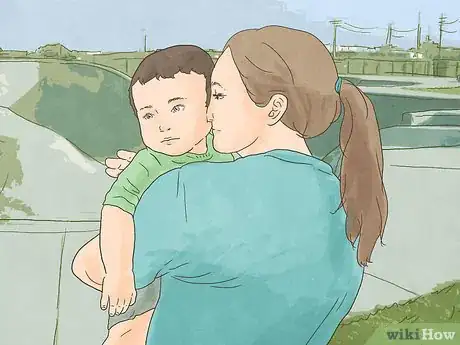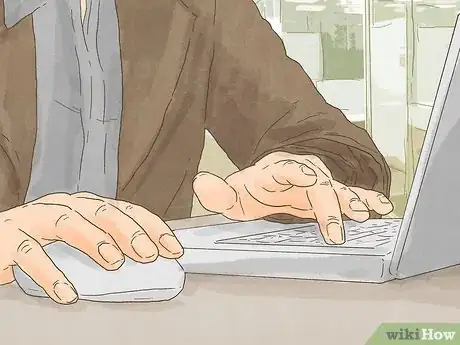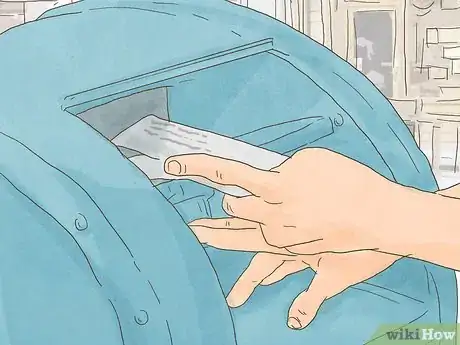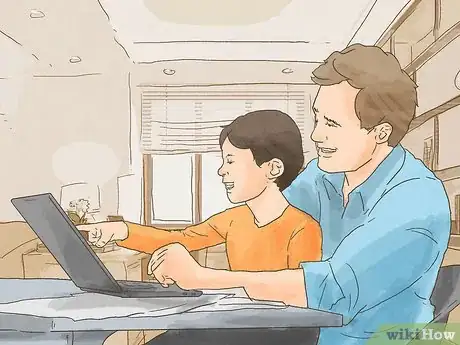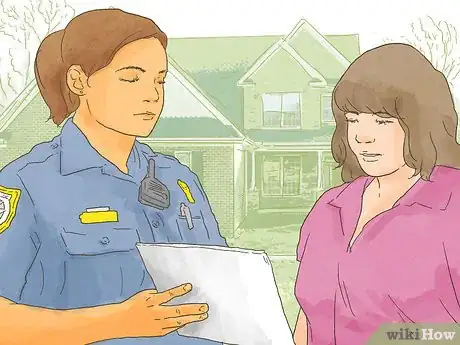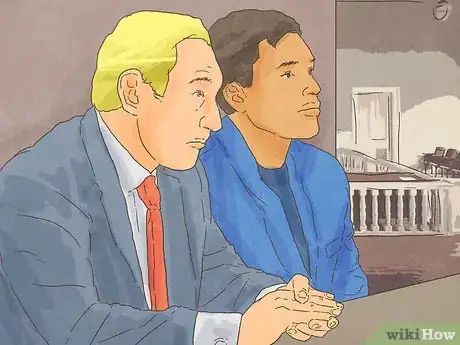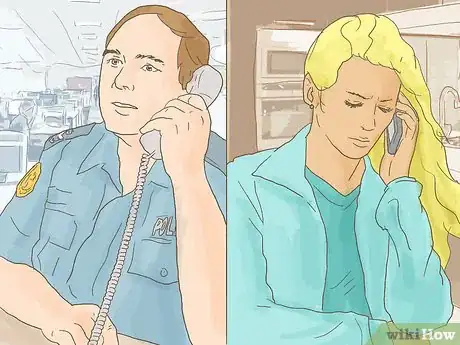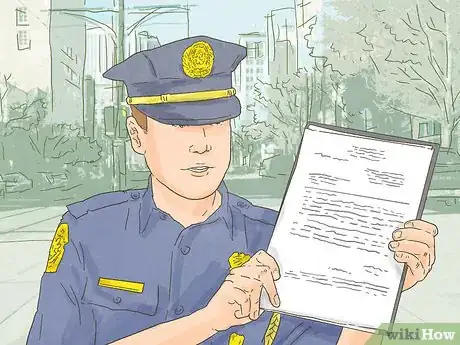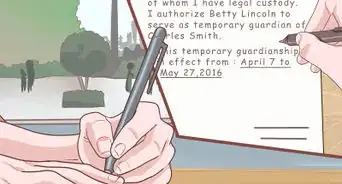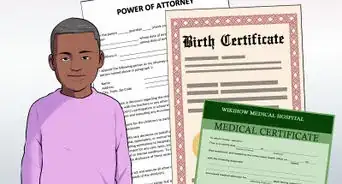This article was co-authored by Clinton M. Sandvick, JD, PhD. Clinton M. Sandvick worked as a civil litigator in California for over 7 years. He received his JD from the University of Wisconsin-Madison in 1998 and his PhD in American History from the University of Oregon in 2013.
There are 12 references cited in this article, which can be found at the bottom of the page.
This article has been viewed 52,700 times.
Moving a child out of state when you have custody can be complicated. In nearly every state, you either need the other parent to give you express permission or you need them not to object. In any event, you probably need to give the other parent notice of the move. You should also talk to a lawyer so that you understand your state’s exact requirements. If you don’t follow your state’s laws, then the other parent might be able to get custody away from you. In order to prevent that from happening, understand exactly what is expected of you and do just that. If you need to move in an emergency situation—for example, because you are being abused—then you should seek a restraining order. As part of the restraining order, you can ask the judge to give you permission to move to another state.
Steps
Checking if You Need Permission
-
1Identify if you have sole custody. In some—but not all—states, you can move your children out of state if you have a permanent order for sole custody. This is the law in California, for example.[1]
- However, many states don’t acknowledge the concept of “sole” custody, and their laws will be very different. Accordingly, you always need to find out your state’s requirements.
-
2Research your state’s laws. Before doing anything, you need to research your state’s requirements. Many states require that you have the other parent’s permission, depending on the circumstances. You should find your state law and read it closely.
- You can search online by searching for “your state” and “move out of state child custody” or something similar.
- If you can’t find anything online, then check with your nearest law library, which is probably at the court house or at a nearby law school.
Advertisement -
3Meet with an attorney. You should also discuss your case with an attorney, who can advise you about whether you need permission to remove the children from the state.[2] If you used an attorney for your divorce, then call this person back up and ask if you can have a meeting.
- You might not have used an attorney when determining initial child custody. In that situation, you can get a referral to a family law attorney by contacting your state or local bar association.
- See Find a Good Family Law Attorney for more information.
-
4Draft a notice. In many states, you must provide written notice to the other parent before you move.[3] You should read your original custody order, which may explain the steps you need to take in order to notify the other parent. A typical notice will provide the following information:
- Your reasons for the move, such as you have a new job or are getting married.
- Your intent to come up with a new visitation schedule that works for the other parent.
- Information about your court case, such as the case number and location of the case (state, county, court name, etc.)
- Your signature.
-
5Mail your notice certified mail. Make sure that you give the other parent sufficient notice. Depending on your state, you may need to give 30, 60, or 90 days’ notice.[4] Also send the notice certified mail, return receipt requested.
- Keep a copy of the notice for your records, and staple the return receipt to your copy.
-
6Obtain written permission. The other parent might agree to the move. In that situation, you should try to get something in writing. Even if your state law allows for an oral agreement, you should still get a written agreement since that can prevent any confusion.[5]
-
7Write a new parenting plan. If the other parent agrees to the move, then you will probably have to draft a new parenting plan, which you both should sign. Take out your copy of the current parenting plan and use it as a guide. You will then need to file the agreement with the court.
- Your new parenting plan should have a visitation schedule for the other parent, and should identify the place of visitation as well as the dates.[6]
- For example, because you are moving far away, you might have the children spend more of their summer or holidays with the other parent.
-
8Avoid leaving the state without permission. Whatever you do, don’t just get in your car and drive off with the child. The other parent can come to the state where you have moved and sue in you court. They can have a court in the new state could then decide to give the other parent sole custody of the children.
- Furthermore, the other parent might convince a judge in the state you left behind to change custody. The parent can then go to your new state and get a judge to enforce that judgment.[7]
- Because you stand to lose possible custody of your children if you move without permission, you should be extra careful that you follow the law.
Getting the Judge’s Permission
-
1Identify why moving is in the child’s best interests. If the other parent won’t agree to the move, then you need to get a judge’s permission to move the child. The judge will analyze whether it is in the child’s best interests to move.[8] Each state has different factors a judge will consider, but generally they will look to the following:[9]
- whether the move will improve the child’s quality of life
- whether your life as the custodial parent will be improved
- what effect reducing the child’s contact with the other parent will have on your children
- how the move will affect the physical, emotional, and other needs of the children
-
2Get evidence to support your argument. You will need to show the judge evidence that the move will be in the child’s best interest. The evidence will differ, depending on the circumstances. For example, the following might be helpful:
- If the other parent rarely visits the child, then keep detailed notes of missed visitation. A judge might be more comfortable granting you permission to leave when the objecting parent hasn’t been involved in the child’s life.[10]
- If you are moving for a new job, then gather evidence, such as a job offer letter and proof of increased income.[11] You should have an actual job offer, not simply be looking.
- You can also try to show that your child will be in a better school if you move. For example, you could gather information about the new school’s graduation rates and its performance on state-wide tests.
-
3Hire a lawyer. In order to get the judge’s permission, you will need to draft a motion and file it with the court. Since this is a complicated legal document, you should probably hire a lawyer to represent you. Your lawyer can draft the motion and file it. They can also argue the motion in front of the judge.
- Money might be tight. In that case, you should stop into the courthouse and check if there is a self-help center or family law facilitator you can speak with.
- You can also try to find legal aid. Legal aid organizations provide reduced-fee or free legal help to people in financial need. Generally, your income must be less than 125% of the federal poverty level.[12] You can find legal aid by visiting the Legal Services Corporation’s website at www.lcs.gov. Click on “Find Legal Aid” and enter your address.
-
4File a motion. You should draft and file a motion in which you explain how the move will be in the child’s best interests. You also should propose a new visitation schedule which will allow the children to maintain their relationship with the other parent.[13] File the motion with the court that awarded you custody, since that court should still have power over your case.
- Depending on your state law, the other parent might have the burden of filing an objection after they receive your notice of intent to move. In that situation, you or your lawyer should receive a copy of the motion. You then will probably have to file a motion in which you explain why the move is in your child’s best interest.
-
5Send notice to the other parent. Whenever you file a document with the court, you have to give the other parent notice. Typically, you can do that by sending a copy of your motion, either by hand delivery or through the mail.
- You generally can’t make delivery yourself. Instead, use the same method you used when sending legal documents during your divorce or original child custody action.
-
6Attend a hearing. At the hearing, the judge will hear evidence about whether the move will be in the best interests of the children. Depending on your child’s age, he or she might testify or, more likely, talk to the judge in private.
- The hearing should not be any different than other hearings you have had in the case before. Whoever brought the motion will probably go first and present their evidence.
- At the end of the hearing, the judge should decide whether to modify the parenting plan and allow you to leave the state.
Leaving in an Emergency Situation
-
1Try to meet with a lawyer. You might be the victim of domestic violence and need to leave quickly in order to protect your safety and your children’s safety. If so, time is of the essence. However, if at all possible, you should try to talk with a lawyer about your options.[14]
- Typically, you need to get a restraining order against the other parent. Your lawyer can help you file for it. You may also be able to file for it yourself.
- In some states, you can just leave so long as you call the local police, the county prosecutor, or Child Protective Services within 24 hours to explain why you left.[15] Ask the lawyer about your state's particular rules.
-
2Get the forms for a restraining order. A restraining order is a judicial command telling the other parent to stop doing something. Generally, you can get a restraining order to prohibit the other parent from contacting you or coming near you. You might also be able to get the judge to agree to let you remove the children from the state.[16] Your courthouse should have forms that you can pick up and fill out.
- Look on the court’s website. Many courts publish their forms online. You can also stop into the court clerk’s office.
-
3Find a phone number to call if it is the weekend. Your emergency might happen on a Friday evening or during the weekend when the court is closed. Many courts have emergency procedures in place so that you can get an emergency restraining order even when the court is closed. You should call your police station and ask.
- Depending on where you live, someone might meet you at the station or at the courthouse and help you complete the paperwork. A judge who is on-call can then grant the emergency restraining order. When court reopens, you will then apply for a restraining order.
-
4Submit your forms. Once you complete all of the forms, you should have someone look them over to make sure that you filled them out accurately. File them with the court clerk. There shouldn’t be a filing fee.
- Ask when you should return. In some courts, you might have to go immediately in front of a judge to answer questions. In other courts, the judge will review the application and make a decision before the end of the day.
-
5Receive a temporary restraining order. The judge has the power to give you a temporary restraining order without hearing from the other parent, who you have accused of abuse. The judge can sign off on the temporary order, which you will serve on the other parent. However, before the judge can give you a permanent restraining order, the other parent must be given an opportunity to appear before the judge.
- Temporary restraining orders last for only a limited amount of time. Generally, they last only 10-14 days.[17]
- Your hearing for a permanent restraining order must be held before the temporary order expires.
-
6Arrange to give the other parent notice. In many counties, the sheriff will make hand delivery for no charge. You will need to give the sheriff information about the other parent, including the following:
- home address
- work address
- description of what the other parent looks like
- picture of the other parent (if you have one)
-
7Attend your hearing. At the hearing, you will need to argue why you are entitled to a permanent restraining order. You should also be prepared to argue why you should be able to leave the state with your children. The other parent will also be able to argue why the restraining order and move aren’t necessary.[18]
- If you win, the judge will sign an order. You should get a copy for your records.
- See Get a Protective Order for more information on enforcing and extending your restraining order.
References
- ↑ http://www.courts.ca.gov/18234.htm
- ↑ http://www.courts.ca.gov/18234.htm
- ↑ http://family.findlaw.com/child-custody/child-custody-relocation-laws.html
- ↑ http://family.findlaw.com/child-custody/child-custody-relocation-laws.html
- ↑ http://www.lsnjlaw.org/Family-Relationships/Custody-Visitation/Relocation-and-Custody/Pages/Can-Child-Move-Out-of-NJ.aspx
- ↑ http://family.findlaw.com/child-custody/child-custody-relocation-laws.html
- ↑ http://www.masslegalhelp.org/children-and-families/moving-out-of-massachusetts-with-your-children
- ↑ http://www.courts.ca.gov/18234.htm
- ↑ http://www.masslegalhelp.org/children-and-families/moving-out-of-massachusetts-with-your-children
- ↑ http://family.findlaw.com/child-custody/child-custody-relocation-laws.html
- ↑ http://www.alabamalegalhelp.org/resource/moving-when-you-have-a-custody-order
- ↑ http://hirealawyer.findlaw.com/do-you-need-a-lawyer/do-you-qualify-for-free-legal-aid.html
- ↑ http://www.lsnjlaw.org/Family-Relationships/Custody-Visitation/Relocation-and-Custody/Pages/Can-Child-Move-Out-of-NJ.aspx
- ↑ http://www.masslegalhelp.org/children-and-families/moving-out-of-massachusetts-with-your-children
- ↑ http://www.lsnjlaw.org/Family-Relationships/Custody-Visitation/Relocation-and-Custody/Pages/Can-Child-Move-Out-of-NJ.aspx
- ↑ http://www.masslegalhelp.org/children-and-families/moving-out-of-massachusetts-with-your-children
- ↑ http://www.masslegalhelp.org/what-happens-after-the-temporary-order
- ↑ http://www.masslegalhelp.org/what-happens-after-the-temporary-order
About This Article
Moving to another state when you have custody of your child can be a bit complicated. The law varies by state, but usually you’ll need the other parent’s permission before you move. If you have permanent sole custody of your child, you can move in some states without permission. In most states, you’ll need to write a notice to the other parent explaining why you’re moving and how you’ll arrange a new visitation schedule. If you have joint custody or your state requires it, you’ll need to get written permission from the child’s parent. If they won’t agree, you’ll need to get a judge’s permission to move. However, you’ll generally only get a judge’s permission if the move will significantly improve your child’s quality of life. For more tips from our Legal co-author, including how to negotiate a new parenting plan with your child’s parent, read on.
